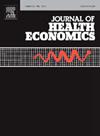养老院的工资补贴以及医疗补助计划参保者在人员配备和获得护理之间的权衡
IF 3.6
2区 经济学
Q1 ECONOMICS
引用次数: 0
摘要
工资补贴是提高养老院人员配备水平的一个很有前途的工具。然而,如果养老院能够吸引更多利润丰厚的非医疗补助居民,那么增加人员可能会以医疗补助计划参保者获得护理的机会为代价。在这项研究中,我考察了1998年至2010年期间国家医疗补助计划提供的一组工资补贴,使用养老院在补贴慷慨程度上的变化来确定补贴效果。我发现每个额外提供的补贴(2010)美元每resident-day每resident-day人员增加了超过10分钟,但降低了医疗补助的新养老院招生大约1.8百分点。这些数字转化为总体平均治疗效果,相当于在补贴前的平均人员配置上增加了约7.4%的人员配置,并且相对于补贴前的基线,医疗补助的入院份额减少了11.5%。补贴还增加了养老院居民的周转,降低了新入院居民的平均护理需求。总体而言,这些结果强调,虽然养老院工资补贴是鼓励增加人员水平的有效工具,但补贴也会导致养老院入院人数和入院居民特征的变化。本文章由计算机程序翻译,如有差异,请以英文原文为准。
Nursing home payroll subsidies and the trade-off between staffing and access to care for Medicaid enrollees
Payroll subsidies are a promising tool for increasing nursing home staffing levels. However, promoting increased staffing may come at the expense of access to care for Medicaid enrollees if it enables nursing homes to attract more lucrative, non-Medicaid residents. In this study, I examine a set of payroll subsidies offered by state Medicaid programs between 1998 and 2010, using nursing home-level variation in subsidy generosity to identify subsidy effects. I find that each additional (2010) dollar of subsidies offered per resident-day increased staffing by just over 10 min per resident-day, but decreased the Medicaid share of new nursing home admissions by about 1.8 percentage points. These figures translate into overall average treatment effects equivalent to an increase in staffing by approximately 7.4% of pre-subsidy average staffing, and a decrease in the Medicaid-share of admissions by 11.5% relative to the pre-subsidy baseline. The subsidies also increased nursing home resident turnover and decreased the average care needs of newly admitted residents. Overall, these results highlight that while nursing home payroll subsidies are effective tools for encouraging increased staffing levels, the subsidies also can lead to changes in nursing home admissions and the characteristics of admitted residents.
求助全文
通过发布文献求助,成功后即可免费获取论文全文。
去求助
来源期刊

Journal of Health Economics
医学-卫生保健
CiteScore
6.10
自引率
2.90%
发文量
96
审稿时长
49 days
期刊介绍:
This journal seeks articles related to the economics of health and medical care. Its scope will include the following topics:
Production and supply of health services;
Demand and utilization of health services;
Financing of health services;
Determinants of health, including investments in health and risky health behaviors;
Economic consequences of ill-health;
Behavioral models of demanders, suppliers and other health care agencies;
Evaluation of policy interventions that yield economic insights;
Efficiency and distributional aspects of health policy;
and such other topics as the Editors may deem appropriate.
 求助内容:
求助内容: 应助结果提醒方式:
应助结果提醒方式:


